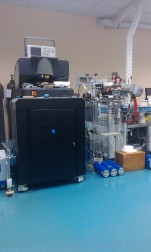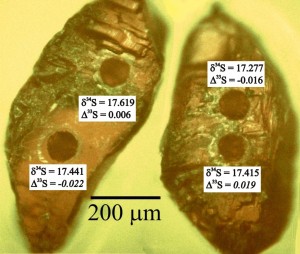Laboratory of Stable Isotopes
Head of the Laboratory, Dr. Tatyana A. VELIVETSKAYA
Tel. +7-(423)-231-85-37
E-mail: This email address is being protected from spambots. You need JavaScript enabled to view it.
 |
The laboratory is one of a few laboratories in Russia that possesses advanced opportunities in research of the light elements stable isotope composition. The laboratory has a number of its own unique techniques, in particular, the only operational facility for determining the stable isotope ratios 18O/16O and 17O/16O in silicates and oxides from the Earth samples and meteorites. Similar isotope study of oxygen can be carried out by only a few scientific laboratories in the world.
For the first time in the worlds practice this laboratory has developed a methodology allowing to perform a local isotopic analysis of sulfur using mass-spectrometric method with fs laser ablation. A new laser ablation method has been developed for measurements of multiple sulfur isotopes (32S, 33S, 34S and 36S) in sulfides using a femtosecond laser ablation system in combination with a reactor for sulfide aerosol conversion into SF6 gas, a cryogenic and chromatographic purification system, and an isotope ratio mass spectrometer (FsLA-GC-IRMS). For the routine analysis of sulfide, a precision of 0.1 – 0.2‰ (1σ) for δ34S and higher than 0.03‰ (1 σ) for ∆33S values has been obtained with an ablation crater size of 80 µm diameter and 40 µm depth.
 |
Mass-spectrometer Thermo Finnigan МАТ 253 should be also outlined from among the equipment of the laboratory that is used for measuring H/D, 13C/12C, 15N/14N, 18O/16O (from СO2 and O2), 34S/32S (from SO2 and SF6) isotopic ratios. Detection H/D could be performed in a helium stream.
 |
 |
In general the laboratory facilities can be involved in various areas of scientific research, including geology (ore deposits genesis, investigating the origin of ore matter and determining physicochemical conditions of its formation), cosmochemistry (formation and evolution of extra-solar matter), biology (food chains and levels issues, physiologic processes mechanisms), ecology (research and forecasting of environmental changes caused by natural processes as well as anthropogenic actions), paleoclimatology (reconstruction of the environmental conditions in the past), expert examination and diagnostic tests (identifying sources for production of alcohol drinks, juices, honey etc.; identifying natural and cultivated ginseng).

